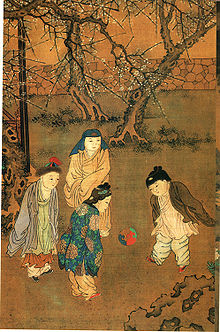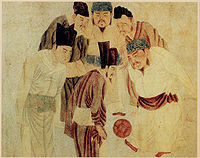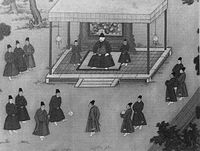- Cuju
-
Cuju (Chinese: 蹴鞠; Mandarin Pinyin: cùjú; Jyutping: Cuk1 guk1; literally "kick ball", pronounced [tsʰûtɕy̌]) is an ancient code of football with similarities to association football. It is seen by some to be a forerunner of modern football [1] and originated in China, and was also played in Korea, Japan and Vietnam.
Contents
History
The game of cuju was first mentioned in the Zhan Guo Ce (under State of Qi's section) and later in the Sima Qian's Shiji (under Su Qin's biography), written during the Han Dynasty.[2] Some[who?] claim that the Yellow Emperor invented the game for military training purposes, while others[who?] place its emergence during China's Warring States Period (476-221 BC). In any case, it certainly existed during this period[when?]. A competitive form of cuju was used as fitness training for military cavaliers, while other forms were played for entertainment in wealthy cities like Linzi.[2]
During the Han Dynasty (206 BC-AD 220), the popularity of cuju spread from the army to the royal courts and upper classes.[3] It is said that the Han emperor Wu Di enjoyed the sport. At the same time, cuju games were standardized and rules were established. Football matches were often held inside the imperial palace. A type of court called ju chang was built especially for cuju matches, which had six crescent-shaped goal posts at each end.
The sport was improved during the Tang Dynasty (618-907).[4] First of all, the feather-stuffed ball was replaced by an air-filled ball with a two-layered hull. Also, two different types of goal posts emerged: One was made by setting up posts with a net between them and the other consisted of just one goal post in the middle of the field. The Tang Dynasty capital of Chang'an was filled with cuju football fields, in the backyards of large mansions, and some were even established in the grounds of the palaces.[5] Soldiers who belonged to the imperial army and Gold Bird Guard often formed cuju football teams for the delight of the emperor and his court.[5] The level of female cuju teams also improved. Records indicate that once a 17-year-old girl beat a team of army soldiers. Cuju football even became popular amongst the scholars and intellectuals, and if a courtier lacked skill in the game, he could pardon himself by acting as a scorekeeper.[5]
Cuju flourished during the Song Dynasty (960-1279) due to social and economic development, extending its popularity to every class in society. At that time, professional cuju players were quite popular, and the sport began to take on a commercial edge. Professional cuju players fell into two groups: One was trained by and performed for the royal court (unearthed copper mirrors and brush pots from the Song often depict professional performances) and the other consisted of civilians who made a living as cuju players.
 One Hundred Children in the Long Spring (长春百子图), a painting by Chinese artist Su Hanchen (苏汉臣, active 1130–1160s AD), Song Dynasty
One Hundred Children in the Long Spring (长春百子图), a painting by Chinese artist Su Hanchen (苏汉臣, active 1130–1160s AD), Song Dynasty
In the Song Dynasty only one goal post was set up in the center of the field. Cuju organizations were set up in large cities called Qi Yun She or Yuan She – now known as the earliest professional cuju club – whose members were either cuju lovers or professional performers. Non-professional players had to formally appoint a professional as his or her teacher and pay a fee before becoming a member. This process ensured an income for the professionals, unlike cuju of the Tang Dynasty.
Gameplay
 Emperor Taizu of Song playing cuju with Prime Minister Zhao Pu, by the Yuan-era painter Qian Xuan (1235–1305)
Emperor Taizu of Song playing cuju with Prime Minister Zhao Pu, by the Yuan-era painter Qian Xuan (1235–1305)
Historically there were two main styles of cuju: "Zhu Qiu" and "Bai Da".
"Zhu Qiu" was commonly performed at court feasts celebrating the emperor's birthday or during diplomatic events. A competitive cuju match of this type normally consisted of two teams with 12-16 players on each side.
"Bai Da" became dominant during the Song Dynasty, a style that attached much importance to developing personal skills. Scoring goals became obsolete when using this method with the playing field enclosed using thread and players taking turns to kick the ball within these set limits. The number of fouls made by the players decided the winner. For example, if the ball was not passed far enough to reach other team members points were deducted. If the ball was kicked too far out, a large deduction from the score would result. Kicking the ball too low or turning at the wrong moment all led to fewer points. Players could touch the ball with any part of the body except their hands whilst the number of players ranged anywhere from two to ten. In the end, the player with the highest score won.
Cuju began to decline during the Ming Dynasty (1368–1644) due to neglect and the 2,000-year-old sport slowly faded away.
Cuju club
In the 10th century, a Cuju club Qi Yun She (齐云社) developed in China; every year there was a national championship Shan Yue Zheng Sai (山岳正赛) organised by Qi Yun She.[citation needed]
Cultural references
- The Hong Kong TVB series A Change of Destiny featured at least one episode based on the cuju competition. Bagua concepts were also used to jinx the opposing team. However it followed more of the modern football (soccer) rules than ancient rules of the game.
- John Woo's epic film Red Cliff features a cuju competition while Cao Cao and others observe on the sideline.
See also
Notes
- ^ http://www.fifa.com/classicfootball/history/game/historygame1.html
- ^ a b Riordan (1999), 32.
- ^ http://www.history.com/minisite.do?content_type=Minisite_Generic&content_type_id=840&display_order=1&mini_id=1343
- ^ http://video.msn.com/video.aspx?mkt=en-US&vid=53c99657-7886-4eeb-8d1b-1f92a61df8b2
- ^ a b c Benn, 172.
References
- Benn, Charles (2002). China's Golden Age: Everyday Life in the Tang Dynasty. Oxford: Oxford University Press. ISBN 0-19-517665-0.
- James, Riordan (1999). Sport and Physical Education in China. London: Spon Press. ISBN 0419220305
External links
Categories:- Ancient sports
- Ball games
- Chinese ancient games
- Sport in Korea
- Traditional football
Wikimedia Foundation. 2010.



